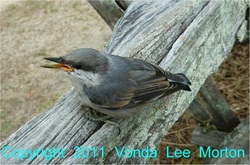
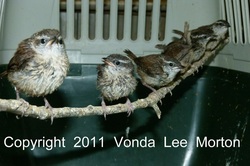
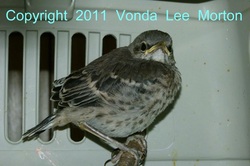
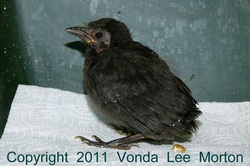
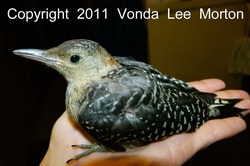
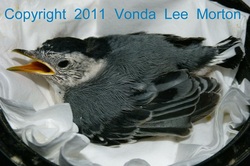
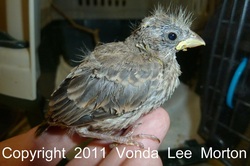

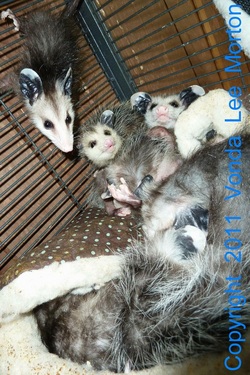
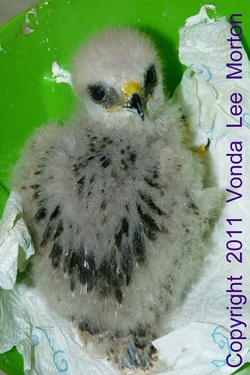
I’ll leave you with this great quote from nature writer Hal Borland that I rediscovered a while back in some of my old notes: You can't be suspicious of a tree, or accuse a bird or squirrel of subversion or challenge the ideology of a violet.
|
Yep, baby season is in full swing, and I’ve got the birds to prove it. So far this month, 18 new intakes have come through the doors, and I’m up to 82 phone calls that didn’t result in the intake of an animal. Hmmm...where to start this update??  The Carolina wren and gnatcatchers were released; the wren didn’t look back; the gnatcatchers continued to come screaming down like little feathered Cruise missiles for about a week, coming from farther away and taking less each time. I’m not seeing them anymore, and I have to admit I miss their cheerful chatter.  I had 6 more Carolina wrens come in—this is apparently the year of small birds! They were nearly ready for the flight pen, so after spending a couple of days inside, into the flight they went, and they’ve also been released. I’m still supplemental-feeding four of them, but they’re a little nervous about the camera now. I’ll try for some photos of them for the next update.  We also have a mocker, who’s in the flight pen now and will be ready for release within the next few days.  Two grackles came in; one didn’t make it. He ate well, but stayed rail-thin and just didn’t seem to grow like the other one (they weren’t sibs). We call this “failure to thrive.” There’s not a real medical reason; it could be that he was the runt of the clutch and was suffering from nutritional deficiencies because his sibs got most of the food—who knows? The other grackle, however, is in fine form and will be headed for the flight pen this week.  This gorgeous little fledgling red bellied woodpecker came in with a broken wing and seemed to be doing fine after we wrapped it; three days after he came in, I found him struggling to perch on his log. His condition worsened over the next several hours, leading to my decision to euthanize him. He was obviously suffering and again, there was no apparent medical reason; my vets and I initially had high hopes that he would be releasable, in fact.  This little white-breasted nuthatch came in starving and severely dehydrated, and I didn’t expect him to make it through the night. He was so dehydrated that when I finally got enough fluids and food in him for him to poop, it was the consistency of putty. When he made it through the night, I was cautiously optimistic, but he didn’t last through the next day.  On the other hand, this little finch came in with the same problem—starvation and dehydration—and is doing great at the moment. Keep your fingers crossed. Finches are so cute with all their “cactus” fuzz; he’s lost most of his, as he was only days away from fledging when he fell from the nest and his finder couldn’t locate the nest to put him back.  This wood duckling looks great in this photo, taken on May 9, but 4 days later, he developed some sort of neck issue. He’s got me and a couple of other rehabbers stumped, as his balance is fine and he walks, swims and runs in a straight line although he seems to be almost developing a hunchback; will update you on his progress in a couple of weeks.  Three of the possums should be released this week. Here you see a pile o’possums; it’s a bit hard to tell where one begins and another ends in the thick of the pile!  And look at the progress of this downy red shoulder! Scroll back down to the May 5 update and look at her when she came in. Now look at these photos. The one at right was taken on May 6, the one below on May 14. Talk about growing like a weed! It’s been a weird year so far; there are several species I tend to see in larger quantities that I haven’t seen any of at all. Notice I’m not being specific, as Murphy’s Law will then kick in and I’ll be inundated with those species!
I’ll leave you with this great quote from nature writer Hal Borland that I rediscovered a while back in some of my old notes: You can't be suspicious of a tree, or accuse a bird or squirrel of subversion or challenge the ideology of a violet.
0 Comments
Why do people lose all common sense upon the discovery of a wild baby? I can almost see the warped logic in attempting to feed baby mammals cow’s milk, but a BIRD??? Yep, the other night I had a call from someone who’d found a nest of just-hatched babies that had fallen from a tree, and all afternoon the babies were fed…HUMAN baby formula. Yeah, you know—the stuff you give human babies: Enfamil or whatever it’s called. Someone PLEASE show me the bird with boobs that led to the assumption that baby birds need milk! For the record, people—the early bird gets the WORM, okay?? Birds do NOT have mammary glands; they do NOT run to the store for a quart of milk or baby formula for their nestlings. Spread the gospel, please! Avian digestive systems aren’t equipped to handle milk; it will kill them. And that’s just what happened. The person who found these baby birds quite literally killed them with (misguided) kindness. They didn’t even make it to me before they died. Now that this update’s rant is out of the way, let’s talk babies! 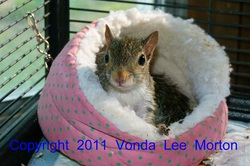 The squirrels have been released; I did manage a couple of pix of them prior to release, despite their increasing camera shyness. 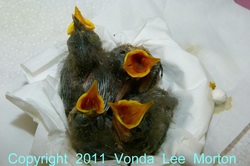 LWR also received a nest of four Carolina wrens that were found in a tractor engine. Two were euthanized: One was a simple case of failure to thrive; the other had a deformed beak that made it impossible for him to preen properly as his feathers came in. One dropped from the flight pen perch during their nightly jostling for position and died, and one was released. 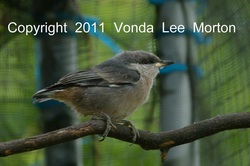 I also received three blue-gray gnatcatchers, tiny, chatty little birds who brought a smile to my face the entire time they were in the flight pen. They’ve been released, as well. Here’s a close-up of one of the little darlings; below is a shot of them and the wrens in the flight pen.  We’re up to 11 possums now, although you can only see six in this shot. The seven from the last update are doing quite well—a proper diet will work wonders! The whole lot are just hissy little rascals who would prefer it if I could put the food in their cage without ever coming near them! 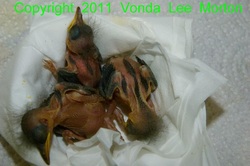 I also had another nest of hatchling Carolina wrens come in, all DOA. When an animal dies within 24 hours of intake, it’s considered DOA, and these poor babies didn’t make it through the night. In this case the finder did everything right. Their nest was found on the ground, covered with ants. The only delay in contacting me was the time it took to remove the ants, so I had these babies less than two hours after they were found. They were ice cold when I got them, however, and the finder said that even though she didn’t run her car air conditioner and kept her hand over the babies to provide warmth on the way to meet me, she could never get them warmed up. There didn’t appear to be any ant bites, but the poor little ones had been too long without food and warmth by the time they were found. Even warming them up and feeding them couldn’t pull them back from the brink of death. 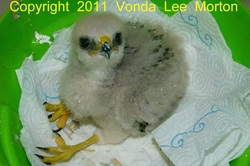 LWR also recently received a downy hawk—we think red shoulder—from DNR. The bird had been through several hands before DNR took possession, and she had the beginnings of pneumonia when I got her. She was beak-breathing and clicking, and I could hear the crackling in her lungs. After consulting with vet Shelley Baumann of Smalley’s Animal Hospital to confirm that the mild antibiotic I keep on hand would be strong enough for this young lady, I started her on antibiotics, and the very next morning there was marked improvement—no beak-breathing or clicking! We don’t always get such quick results, but this little girl—we’re pretty sure she’s female, given her rather hefty weight for her young age—was lucky in that we caught her pneumonia early and it responded well to treatment. 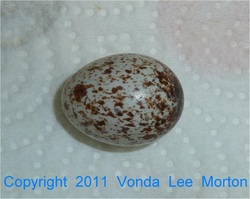 I also had an unidentified egg come in; it was found on the ground after a tree was cut down, but no nest was located. I suspect it’s sterile and was left in the nest after the babies who had hatched fledged, but since candling it has been inconclusive so far, I’m incubating it for a few more days to see what may or may not happen. There are several species whose eggs resemble this one, so it would be neat if it hatched, if for no other reason than to see which species it is! For April, LWR had 36 intakes, so baby season is officially in full gear now!
|
Archives
April 2023
Categories
All
|